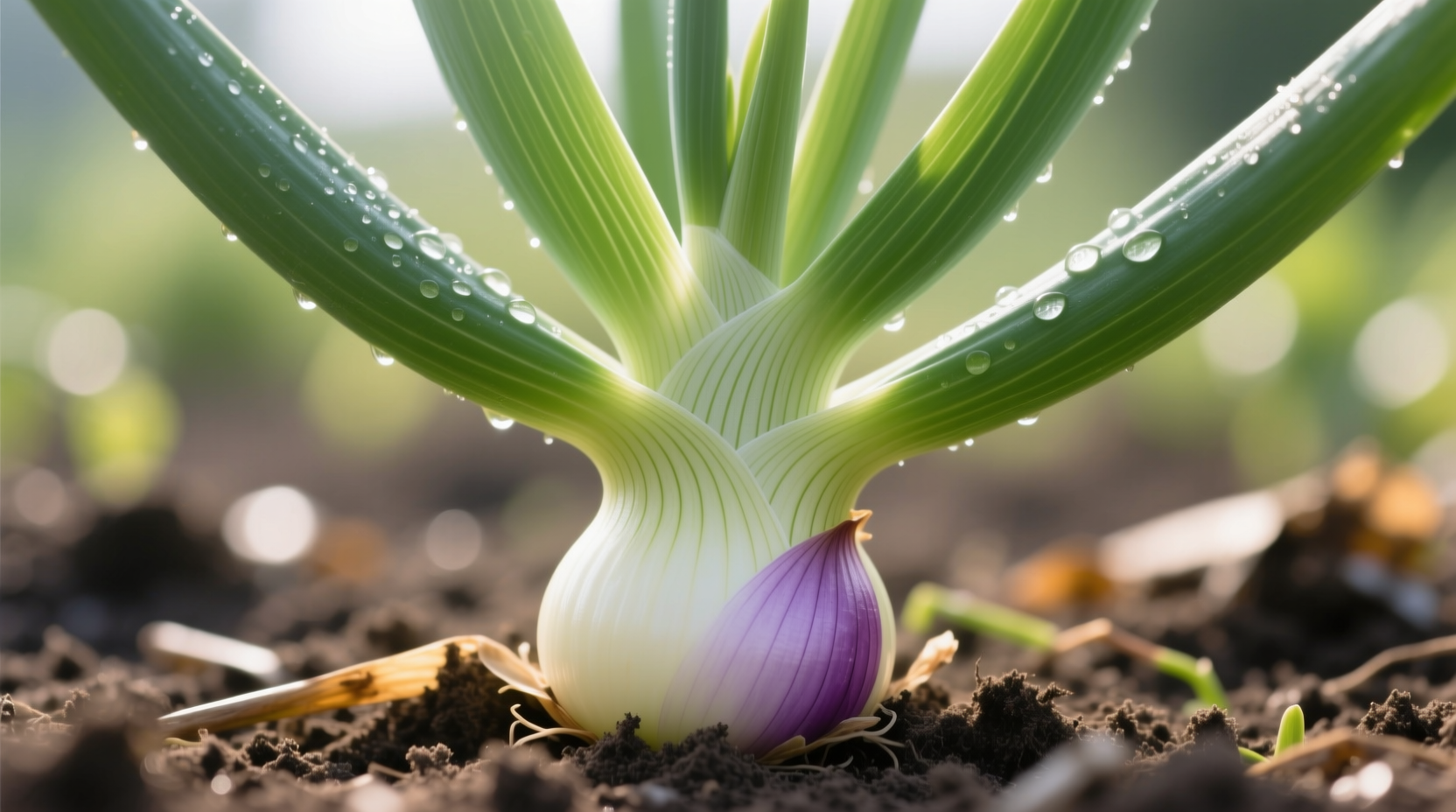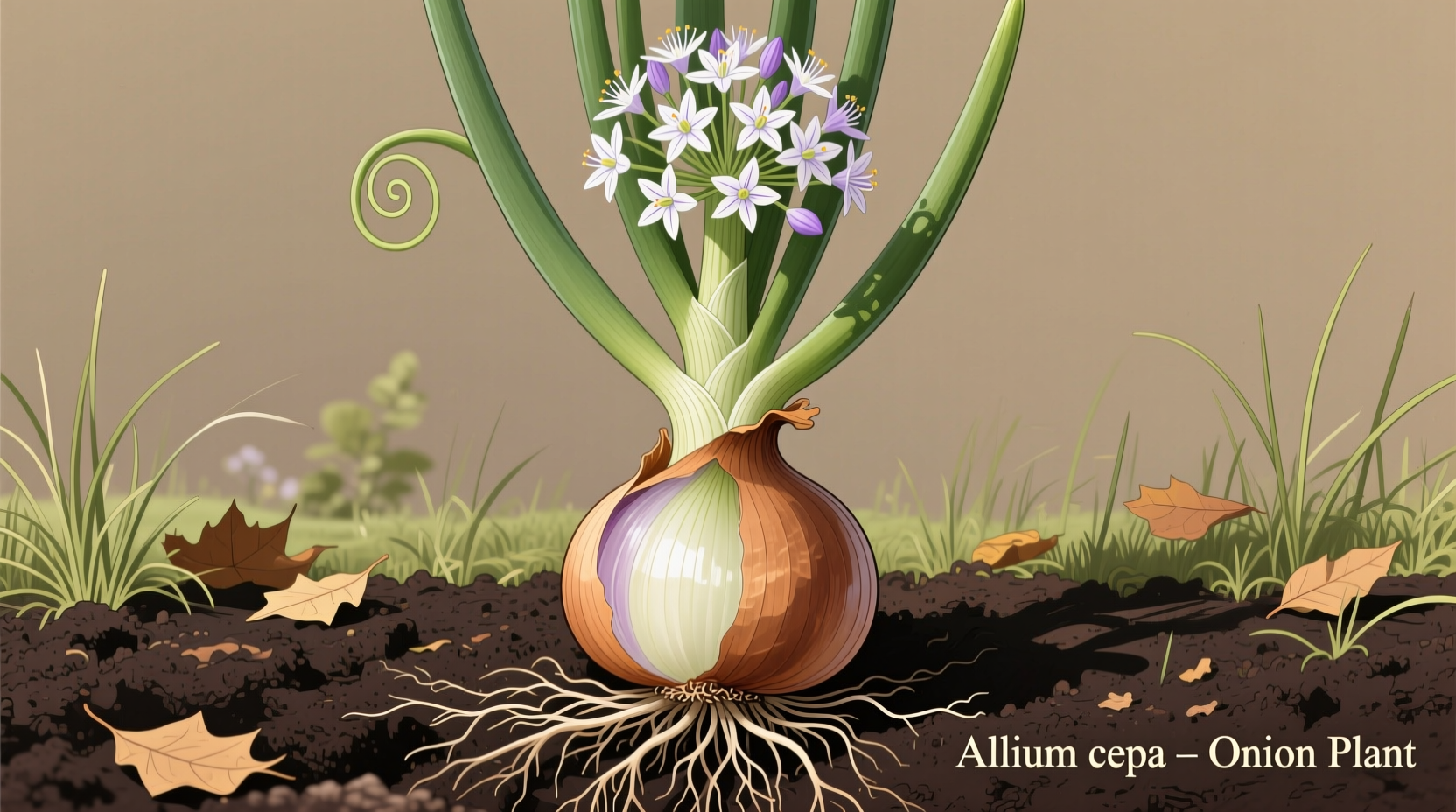If you're wondering what an onion plant looks like, here's the direct answer: Onion plants (Allium cepa) feature hollow, cylindrical green leaves that grow in a fan-like arrangement from the base. The leaves are bluish-green, slightly waxy, and emit a distinct onion scent when crushed. Below ground, the bulb develops as overlapping white or purplish layers. At maturity, some varieties produce spherical flower heads with white or pink blossoms.
Whether you're a beginner gardener trying to identify your first crop or need to distinguish onion plants from look-alikes in your garden, understanding their visual characteristics is essential. This guide provides a comprehensive visual reference to help you confidently recognize onion plants at every growth stage.
Onion Plant Growth Timeline: From Seed to Harvest
Understanding the progression of onion plant development helps with proper identification and care. Here's what to expect at each stage:
Weeks 1-2: Germination and Seedling Stage
After planting, onion seeds typically germinate in 7-14 days. The first sign of growth is thin, straight green shoots emerging from the soil. These initial seedlings resemble blades of grass but have a distinctive hollow structure when examined closely. The seedlings grow vertically at first, reaching 2-4 inches in height.
Weeks 3-8: Leaf Development and Bulb Initiation
As the plant matures, the leaves become more robust and develop their characteristic cylindrical, hollow structure. The leaves grow in a fan pattern from the base, with new leaves emerging from the center. This is when the bulb begins forming underground - you won't see it yet, but the plant's energy shifts toward bulb development. The leaves reach 8-12 inches in height and develop a bluish-green hue with a slightly waxy coating.
Weeks 9-16: Bulb Formation and Maturation
During this critical phase, the bulb expands significantly beneath the soil surface. The leaves continue growing to 12-18 inches tall, but you'll notice the lower portion begins to yellow and fall over as the plant directs energy to bulb development. The neck of the plant (where leaves meet the bulb) becomes more pronounced. Some varieties may produce flower stalks with spherical umbels containing small white or pink flowers.
Harvest Time: Final Growth Stage
When approximately half the leaves have turned yellow and fallen over, the onion is ready for harvest. Carefully dig around the plant to reveal the mature bulb, which should be firm and have developed its characteristic outer skin color (white, yellow, or red depending on variety).
Key Visual Identification Features of Onion Plants
Knowing these distinctive characteristics will help you positively identify onion plants in your garden or in the wild:
Leaf Structure and Appearance
Onion plant leaves arehollow and cylindrical, unlike many other plants with flat leaves. They grow in afan-like arrangement from the base, with new growth emerging from the center. The leaves have abluish-green color with awaxy coating that gives them a slightly shiny appearance. When broken or cut, they release thecharacteristic onion aroma - this is the most reliable identification method.

Bulb Development Characteristics
While the bulb develops underground, you can identify its progress by observing the plant above ground. As the bulb forms, theneck of the plant becomes more pronounced, and theleaves begin to yellow from the tips downward. Thesoil around the bulb may crack as it expands. Unlike some similar plants, onion bulbs formdistinct layered structures rather than single solid bulbs.
How Onion Plants Compare to Common Look-Alikes
Mistaking other plants for onions can be dangerous, as some look-alikes are toxic. This comparison table helps you distinguish onion plants from similar species:
| Plant | Leaf Characteristics | Smell Test | Flower Structure | Safety |
|---|---|---|---|---|
| Onion (Allium cepa) | Hollow, cylindrical, bluish-green leaves in fan arrangement | Strong onion/garlic scent when crushed | Spherical umbel with small white/pink flowers | Edible |
| Wild Garlic (Allium ursinum) | Flat, solid leaves with prominent central vein | Garlic scent, stronger than onion | White star-shaped flowers in clusters | Edible |
| Chives (Allium schoenoprasum) | Hollow but much thinner leaves, uniform diameter | Mild onion scent | Spherical purple flower heads | Edible |
| Death Camas (Toxic) | Flat, solid leaves with waxy coating | No onion scent (may have no scent or unpleasant odor) | White flowers in loose clusters | Poisonous |
| Bluebell (Toxic) | Flat, solid leaves in basal rosette | No onion scent | Blue bell-shaped flowers hanging from one side | Poisonous |
Important safety note: Always perform the smell test before consuming any wild allium species. If it doesn't smell distinctly like onion or garlic, do not eat it. Some toxic plants closely resemble edible alliums but lack the characteristic aroma.
Practical Identification Tips for Gardeners
Whether you're growing onions or trying to identify volunteer plants, these practical tips will help:
When Seedlings First Emerge
Early identification can prevent accidental weeding of young onion plants. Look forthin, straight shoots that areslightly thicker than grass blades. Gently pinch a seedling - if it's an onion, you'll detect afaint onion scent. True leaves will develop thehollow structure within 2-3 weeks of germination.
Differentiating Between Onion Varieties
While all onion plants share basic characteristics, different varieties have subtle distinctions:
- Yellow onions: Most common garden variety, green leaves with slight blue tint
- Red onions: May have purple tinges in leaves, especially in cooler weather
- White onions: Brighter green leaves, often slightly more robust growth
- Green onions/scallions: Thinner leaves, less bulb development, milder scent
Common Identification Mistakes to Avoid
Gardeners often confuse onion plants with:
- Grass: Grass has flat or folded leaves with a ligule (small membrane) where the leaf meets the stem - onions lack this feature
- Wild garlic: Has flat leaves rather than hollow ones, stronger garlic scent
- Daylilies: Young daylily shoots resemble onions but have flat leaves and no onion scent
When to Harvest Based on Visual Cues
Knowing what your onion plants should look like at maturity helps determine the perfect harvest time:
- Bulb size: The bulb should feel firm and have reached the expected size for your variety
- Leaf condition: Approximately 50% of leaves should have yellowed and fallen over
- Neck condition: The neck should be thinning and beginning to collapse
- Outer skin: Should be dry and papery, with characteristic color for the variety
Harvesting too early results in small bulbs with poor storage capability, while harvesting too late can cause the protective outer layers to rot. The visual cues above provide the most reliable indicators for optimal harvest timing.
Frequently Asked Questions
What do onion seedlings look like when they first sprout?
Onion seedlings first appear as thin, straight green shoots resembling grass but slightly thicker. Within 7-14 days of planting, they reach 2-4 inches tall. The true leaves that follow have a hollow, cylindrical structure and emit a faint onion scent when crushed. Unlike grass, onion seedlings grow in a fan-like arrangement from the base rather than individual stalks.
How can I tell if my onion plants are ready to harvest?
Onion plants are ready for harvest when approximately half of the leaves have turned yellow and fallen over. The neck of the plant (where leaves meet the bulb) will begin to thin and collapse. You may notice the soil cracking around the bulb as it expands to full size. The outer skin should feel dry and papery when gently rubbed. These visual cues indicate the bulb has matured and is ready for harvesting.
What's the difference between onion plants and chives?
While both are in the Allium family, onion plants and chives have distinct differences. Onion leaves are hollow but wider (about 1/4 inch diameter) with a bluish-green color, while chive leaves are thinner (pencil-lead size), uniform in diameter, and brighter green. Onions develop substantial underground bulbs, whereas chives produce small, clustered bulbs. When crushed, onions have a stronger scent than the more delicate chive aroma. Chives produce purple flower heads, while onions typically have white or pink flowers.
Can onion plants flower, and what do the flowers look like?
Yes, mature onion plants can produce flowers, especially if exposed to temperature fluctuations. The flowers appear in a spherical umbel (cluster) at the top of a hollow stalk. Each umbel contains numerous small star-shaped flowers that are typically white or pink, though some varieties may have purple hues. Flowering usually indicates the plant is bolting, which can reduce bulb quality, but the flowers themselves are edible and have a mild onion flavor.
Why do my onion plant leaves turn yellow from the top down?
Yellowing leaves from the top down is a natural part of onion plant maturation and indicates the bulb is nearing harvest readiness. As the plant directs energy to bulb development, the older leaves at the top begin to senesce (age and die back). When approximately half of the leaves have yellowed and fallen over, the bulb has typically reached full size and the protective outer layers have formed. This natural yellowing process differs from disease-related yellowing, which often shows patterns like streaking or spotting.











 浙公网安备
33010002000092号
浙公网安备
33010002000092号 浙B2-20120091-4
浙B2-20120091-4